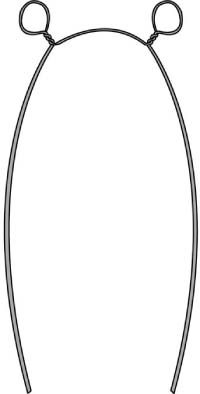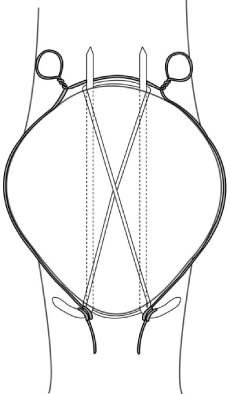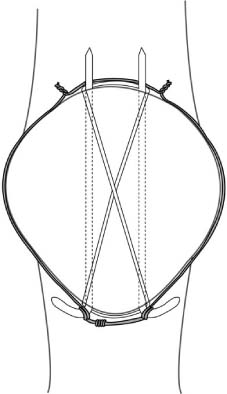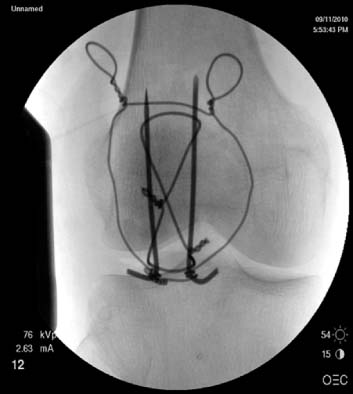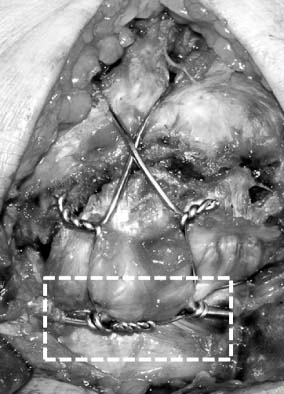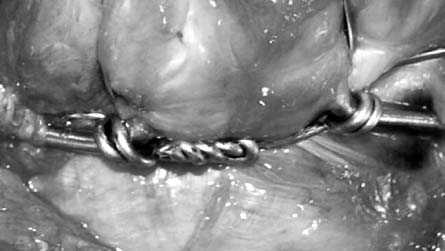J Korean Fract Soc.
2013 Oct;26(4):321-326. 10.12671/jkfs.2013.26.4.321.
Modified Tension Band Wiring Combined with Anti-Gliding Loop Augmentation Technique for the Treatment of Comminuted Patellar Fracture: Technical Note and Report of Early Results: Technical Note
- Affiliations
-
- 1Department of Orthopedic Surgery, Chung-Ang University College of Medicine, Seoul, Korea.
- 2Department of Orthopedic Surgery, Dongguk University Ilsan Hospital, Goyang, Korea. jaejunyang@gmail.com
- KMID: 2183834
- DOI: http://doi.org/10.12671/jkfs.2013.26.4.321
Abstract
- In order to investigate the feasibility of a modified tension band combined with anti-gliding loop augmentation technique for the treatment of comminuted patellar fracture, 21 patients with comminuted patellar fracture were enrolled in this study. After the modified tension band wiring of patellar fracture, a cerclage wire was passed around the patella. Anti-gliding loops were made on the bending sites of Kirshner-wires. A knot was tied using both ends of the anti-gliding loops, and the cerclage wire was tightened using proximal knots. Bone union was achieved at 4.5+/-1.5 months postoperatively without nonunion. The Lysholm score was 87.1+/-2.8, and the range of motion of the knee was 2.1degrees+/-3.4degrees to 132.2degrees+/-6.5degrees at the last follow-up. The modified tension band combined with anti-gliding loop augmentation technique might be considered an alternative modification of modified tension band wiring for the treatment of comminuted patellar fracture.
Keyword
Figure
Reference
-
1. Boström A. Fracture of the patella. A study of 422 patellar fractures. Acta Orthop Scand Suppl. 1972; 143:1–80.
Article2. Kinik H, Us AK, Mergen E. Self-locking tension band technique. A new perspective in tension band wiring. Arch Orthop Trauma Surg. 1999; 119:432–434.3. Lotke PA, Ecker ML. Transverse fractures of the patella. Clin Orthop Relat Res. 1981; (158):180–184.
Article4. Macko D, Szabo RM. Complications of tension-band wiring of olecranon fractures. J Bone Joint Surg Am. 1985; 67:1396–1401.
Article5. Murphy DF, Greene WB, Dameron TB Jr. Displaced olecranon fractures in adults. Clinical evaluation. Clin Orthop Relat Res. 1987; (224):215–223.
Article6. Smith ST, Cramer KE, Karges DE, Watson JT, Moed BR. Early complications in the operative treatment of patella fractures. J Orthop Trauma. 1997; 11:183–187.
Article7. Weber MJ, Janecki CJ, McLeod P, Nelson CL, Thompson JA. Efficacy of various forms of fixation of transverse fractures of the patella. J Bone Joint Surg Am. 1980; 62:215–220.
Article8. Wild M, Windolf J, Flohé S. Fractures of the patella. Unfallchirurg. 2010; 113:401–411.9. Wu CC, Tai CL, Chen WJ. Patellar tension band wiring: a revised technique. Arch Orthop Trauma Surg. 2001; 121:12–16.
Article10. Yotsumoto T, Nishikawa U, Ryoke K, Nozaki K, Uchio Y. Tension band fixation for treatment of patellar fracture: novel technique using a braided polyblend sutures and ring pins. Injury. 2009; 40:713–717.
Article
- Full Text Links
- Actions
-
Cited
- CITED
-
- Close
- Share
- Similar articles
-
- Tension band wiring and Modified tension band wiring in the Operative Treatment of Patella Fracture
- Operative Treatment of patellar Fractures
- Change of Patellar Length after Internal Fixation of the Patellar Fracture
- Treatment of patellar Fractures with Modified Tension Band Wiring
- Results of Surgical Treatment of Patellar Fractures: With Tension Test for the Rigidity of Fixation Methods

